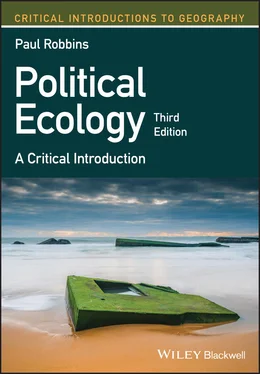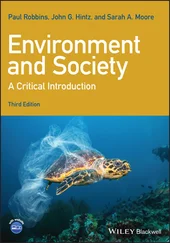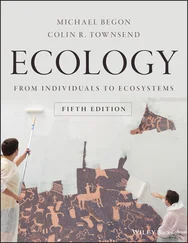These are the questions of political ecology, a field of critical research predicated on the assumption that any tug on the strands of the global web of human–environment linkages reverberates throughout the system as a whole. This burgeoning field has attracted several generations of scholars from the fields of anthropology, forestry, developmental studies, environmental sociology, environmental history, and geography. Its countless practitioners all query the relationship between economics, politics, and nature but come from varying backgrounds and training. Some are physical scientists (e.g., biologists, geomorphologists, and hydrologists), others are methodological technicians (e.g., geographic information or remote sensing specialists), while most are social scientists. All share an interest in the condition of the environment and the people who live and work within it. These researchers, moreover, advocate fundamental changes in the management of nature and the rights of people, directly or indirectly working with state and non‐governmental organizations (NGOs) to challenge current conditions. This book reviews the work that these people do, pointing towards the common factors evident in a research area often noted for its diversity, and revealing the strengths and weaknesses in a field that has grown far too quickly to prepare a comprehensive survey or census of its accomplishments and failures.
What is Political Ecology?
The term political ecology is a generous one that embraces a range of definitions. A review of the term from its early use (first used to describe this kind of work by Wolf in 1972) to its most recent manifestations shows important differences in emphasis. Some definitions stress political economy, while others point to more formal political institutions; some stress environmental change, while others emphasize narratives or stories about that change (see Table 1.1). Even so, there seems to be a set of common elements. The many definitions together suggest that political ecology represents an explicit alternative to “apolitical” ecology, that it works from a common set of assumptions, and that it employs a reasonably consistent mode of explanation.
Table 1.1 Defining political ecology.
| Author/source |
Definition of “political ecology” |
Goal |
| Cockburn and Ridgeway (1979) |
“a useful way of describing the intentions of radical movements in the United States, in Western Europe and in other advanced industrial countries … very distant from the original rather sedate operations of the ecolobby” (p. 3) |
Explicate and describe first‐world urban and rural environmental degradation from corporate and state mismanagement; document social activism in response. |
| Blaikie and Brookfield (1987) |
“combines the concerns of ecology and a broadly defined political economy. Together this encompasses the constantly shifting dialectic between society and land‐based resources, and also within classes and groups within society itself” (p. 17) |
Explain environmental change in terms of constrained local and regional production choices within global political economic forces, largely within a third‐world and rural context. |
| Greenberg and Park (1994) |
A synthesis of “political economy, with its insistence on the need to link the distribution of power with productive activity and ecological analysis, with its broader vision of bio‐environmental relationships” (p. 1) |
“Synthesize the central questions asked by the social sciences about the relations between human society, viewed in its bio‐cultural‐political complexity, and a significantly humanized nature” (p. 1). |
| Peet and Watts (1996b) |
“a confluence between ecologically rooted social science and the principles of political economy” (p. 6) |
Locates “movements emerging from the tensions and contradictions of under‐production crises, understands the imaginary basis of their oppositions and visions for a better life and the discursive character of their politics, and sees the possibilities for broadening environmental issues into a movement for livelihood entitlements, and social justice” (pp. 38–39). |
| Forsyth (2003) |
“the politics of ecology as a scientific legitimization environmental policy” (p. 4) |
To “establish the political forces behind different accounts of ‘ecology’ as a representation of biophysical reality” (p. 4) |
| Heynen, Kaika, and Swyngedouw (2006b) |
“formulating political projects that are radically democratic in terms of the organization of the processes through which the environments that we (humans and non‐humans) inhabit become produced” (p. 2) |
To “untangle the interconnected economic, political, social and ecological processes that together form highly uneven urban socio‐physical landscapes” (p. 16) |
| Bridge, McCarthy, and Perreault (2015a) |
An environmental research field marked by a set of “common commitments” to “critical social theory”, to “in‐depth, direct observation involving qualitative methods”, and a “normative political commitment to social justice and structural political change” (pp. 7–8) |
“not just to explain social and environmental processes, but to construct an alternative understanding of them, with an orientation to social justice and radical politics” (p. 8) |
Challenging apolitical ecologies
If there is a political ecology, by implication there must be an apolitical one. As such, research in the field commonly presents its accounts, whether explaining land degradation, local resource conflict, or state conservation failures, as an alternative to other perspectives. The most prominent of these apolitical approaches, which tend to dominate in global conversations surrounding the environment, are “ecoscarcity” and “modernization” accounts.
It is not my intention to provide sustained criticisms of these two approaches here; later chapters of the book should reveal the characteristics of these perspectives and demonstrate their ethical and practical weaknesses. An outline of each should suffice to present their basic arguments, with which readers are probably already very familiar, common as these approaches are to most environmental explanation.
Ecoscarcity and the limits to growth
The dominant contemporary narrative of environmental change and human–environment interaction is a well‐established one with a long history. In Western Europe since the late 1700s, when human influence and response to the environment was first submitted to scientific scrutiny, the central driving explanation for social/ecological crisis has been increasing human population, measured in absolute numbers. Following from Thomas Malthus' Essay on the Principle of Population , the argument is straightforward: as human populations grow out of proportion to the capacity of the environmental system to support them, there is a crisis both for humans, whose numbers fall through starvation and disease‐based mortality, and for nature, whose overused assets are driven past the point of self‐renewal. This argument took many forms during the twentieth century, from the Population Bomb of Paul Ehrlich (1968) to the Club of Rome's Limits to Growth (Meadows et al. 1972), but its elements are consistent. All hold to the ultimate scarcity of non‐human nature and the rapacity of humankind's growing numbers.
For ecoscarcity proponents, this is nowhere a more serious problem than that in the underdeveloped world, where growth rates and absolute numbers of people remain the highest in the world. That the poorest regions of the world are the repositories for what are viewed as important and scarce environmental goods makes the problem doubly serious. In this way of thinking, the perilous decline of Kenya's wildlife, as described above, can be predicted to follow inevitably from the growth of Kenya's population.
Читать дальше












